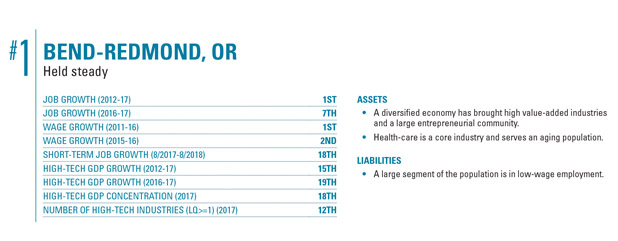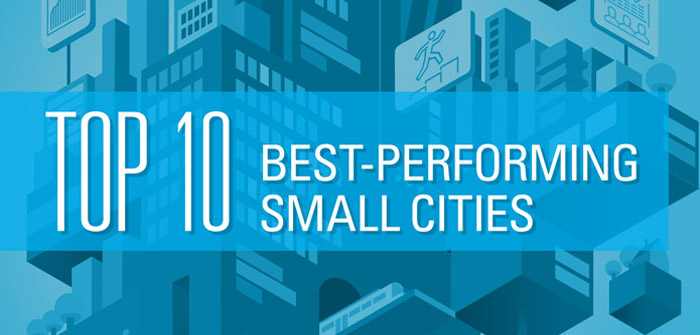(Graphic and tables | Courtesy of Milken Institute)
Small cities in the U.S. have seen economic growth in the healthcare, knowledge-based, amenity focused, manufacturing and logistics sectors. Healthcare industries in smaller metros benefit from lower living costs increasing the concentration of retirees. Places offering more amenities have seen growth as well. The tourism industry can also provide a competitive advantage to cities. Lower cost areas have seen growth in high-tech industries and manufacturing. Smaller metros have overall lower costs for businesses, which can help attract labor-dependent employment. Higher cost major cities have pushed segments of their populations to smaller cities with lower living costs and a higher quality of life.

The 2018 edition of the Best-Performing Small Cities index ranks 201 U.S. metros. There have been no new additions to the set of cities from the previous release. This year, five of the metros return to the Top 10 small cities. Many of the Top 10 metros have benefited from growing populations and in-migration. In small cities, housing and construction growth is a critical part of the economic landscape this year. The next most influential industries are healthcare and manufacturing. Bend-Redmond, OR; St. George, UT; Coeur d’Alene, ID; and Medford, OR, have healthcare industries supported by an aging population. A common additional feature that has provided growth is the leisure and hospitality industry, which makes these metros more attractive to retirees. Manufacturing cities such as Gainesville, GA; Elkhart-Goshen, IN; Albany, OR; and Logan, UT, all heavily depend on their core manufacturers, specifically food production or vehicle manufacturing. Logistic hubs and agriculture-based economies are represented in the Top 10 this year. Albany, OR, and Elkhart-Goshen, IN, have greatly benefited from the performance of their key sectors. The renegotiations of NAFTA and the impact of tariffs will present new challenges for trade-dependent metros. College towns and the high-tech sector account for the remaining economic drivers, as exemplified by the University of Georgia and the University of Utah in Athens-Clarke County, GA, and Logan, UT, respectively, or San Rafael, CA, in the Bay Area.

Bend-Redmond, OR sees its third consecutive year ranking No. 1 on the BPC Small Cities index. All of the variables in the Bend-Redmond rank in the Top 20, securing its No. 1 rank this year. The metro’s five-year job and wage growth both rank first and one-year wage growth ranks second, which continues to show the region’s ability to increase high-value employment. Five-year high-tech GDP growth climbed 118 places from last year’s ranking, showing the recent dramatic growth of the high-tech sector. The job, wage, and high-tech GDP five-year growth values are 19.9 percent, 25.2 percent, and 18.0 percent, respectively. Economic growth is also exemplified by a $5.2 million expansion to meet demand at the regional Redmond airport, one of the few options to get people from outside the region to Bend-Redmond.136
The high-tech sector has become an anchor industry for the metro, which diversifies the economy beyond healthcare and tourism. The metro’s high-tech GDP grew 4.1 percent from 2016-2017, continuing year-over-year rank increases. The risk capital and entrepreneurial infrastructure expanded in 2018 when Oregon State University-Cascades (OSUCascades) opened its Innovation Co-Lab. The Co-Lab joins various incubators and investment funds in Bend that provide support for the high-tech sector. The knowledgebased economic engine of the metro should continue to see growth as the university continues to provide new graduates. The class of 2018 graduated a total of 368 students, 90 of which earned master’s degrees.137 The presence of the Central Oregon Community College should also provide affordable higher education for the resident population. Access to post-secondary education will be important going forward to maintain high levels of educational attainment.138
Bend-Redmond has become a place for entrepreneurship driven by tech and biotech. A recent example of Bend successfully taking advantage of new markets in the tech sector is Dutchie, an e-commerce cannabis retailer that brought in a $3 million investment from Casa Verde Capital as well as others like the venture capital firm The Durant Company.139 Online pet gear retailer Ruffwear received $250,000 from the Governors Strategic Reserve Fund as part of an expansion plan that includes co-working space for local entrepreneurs. Seven Peaks Ventures closed its second fund of $28 million and has donated $62,500 to the computer science program at OSU-Cascades.140
Bend-Redmond saw net migration of 5,133 people for 2015- 2016, which continues to fuel rising housing prices.141 The overall population grew 3.1 percent since the last edition of BPC. The housing market has since experienced year-overyear price increases of close to 10 percent.142 The number of single-family housing permits being issued has so far not kept up with demand, which is contributing to rising housing prices.143 However, the housing market is relatively inexpensive compared to the U.S., which will continue to attract people from outside the metro.144
Since 2008, Bend-Redmond has seen the population of 65+ residents increase significantly. The increase in retirees continues to support the healthcare industry. The low cost of living has been one aspect of the appeal to retirees, along with the large leisure and hospitality capacity provided by the tourist industry, which is the metro’s foundational sector. St. Charles Medical Center is still the largest employer with 3,361 staff, which is a 36.2 percent increase from 2017 data releases.145 The growth in the healthcare industry is exemplified by the regional hospital. The impact of retirees in the metro plays a major role in the region’s composition of income, as well. Nonwage income makes up 60 percent of total personal income in Bend-Redmond.146 The presence of such a large population aged 65 and over should help support the metro’s foundational healthcare, leisure, and hospitality industries for the foreseeable future.
136KTVZ COM news sources. “Redmond Airport Gets $5.2 Million Expansion Grant.” KTVZ, August 23, 2018.
https://www.ktvz.com/news/redmond-airport-gets-52-million-expansion-grant/784893252.
137KTVZ COM news sources. “OSU-Cascades Class of 2018 Totals 368 Graduates,” KTVZ, June 11, 2018.
https://www.ktvz.com/news/osu-cascades-class-of-2018-totals-368-graduates/751819590.
138Matsiras, Paul. “Bend-Redmond, OR.” Metro-Précis, Moody’s Analytics, October 07, 2018.
139McLaughlin, Kathleen. “Snoop Dogg’s Venture Fund Invests in Bend Startup.” The Bulletin, September 25, 2018.
http://www.bendbulletin.com/business/6547158-151/snoop-doggs-venture-fund-invests-in-bend-startup.
140McLaughlin, Kathleen. “Venture Capitalists’ Gift Supports Computer Science at OSU-Cascades.” The Bulletin, October 19,
2018. http://www.bendbulletin.com/business/6608378-151/venture-capitalists-gift-supports-computer-science-at-osu-cascades.
“Bend’s Early-Stage Backers Seven Peaks Ventures Close $28M Fund.” Portland Business Journal, September 13, 2018.
https://www.bizjournals.com/portland/news/2018/09/13/bends-early-stage-backers-close-28m-fund.html.
141Matsiras, Paul. “Bend-Redmond, OR.” Metro-Précis, Moody’s Analytics, October 7, 2018.
142Ibid.
143Ibid.
144Ibid.
145Ibid.
146Ibid.





